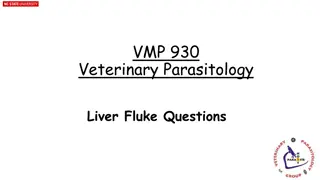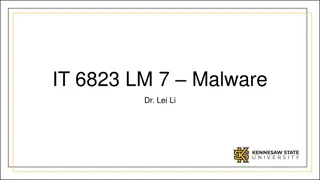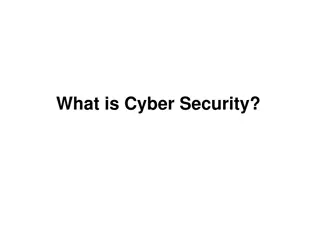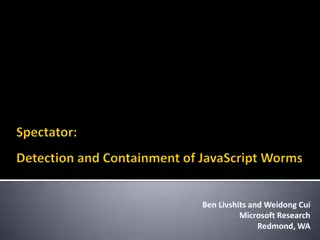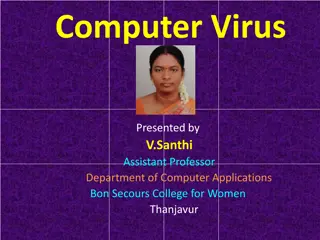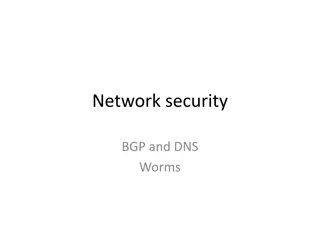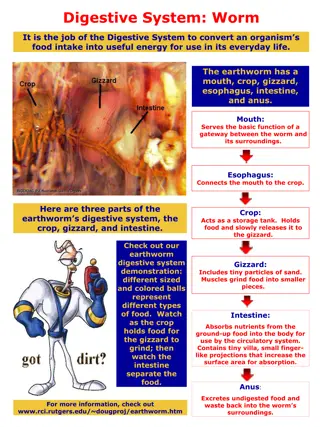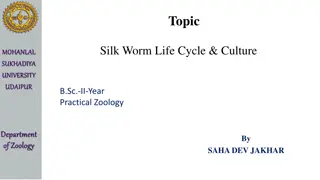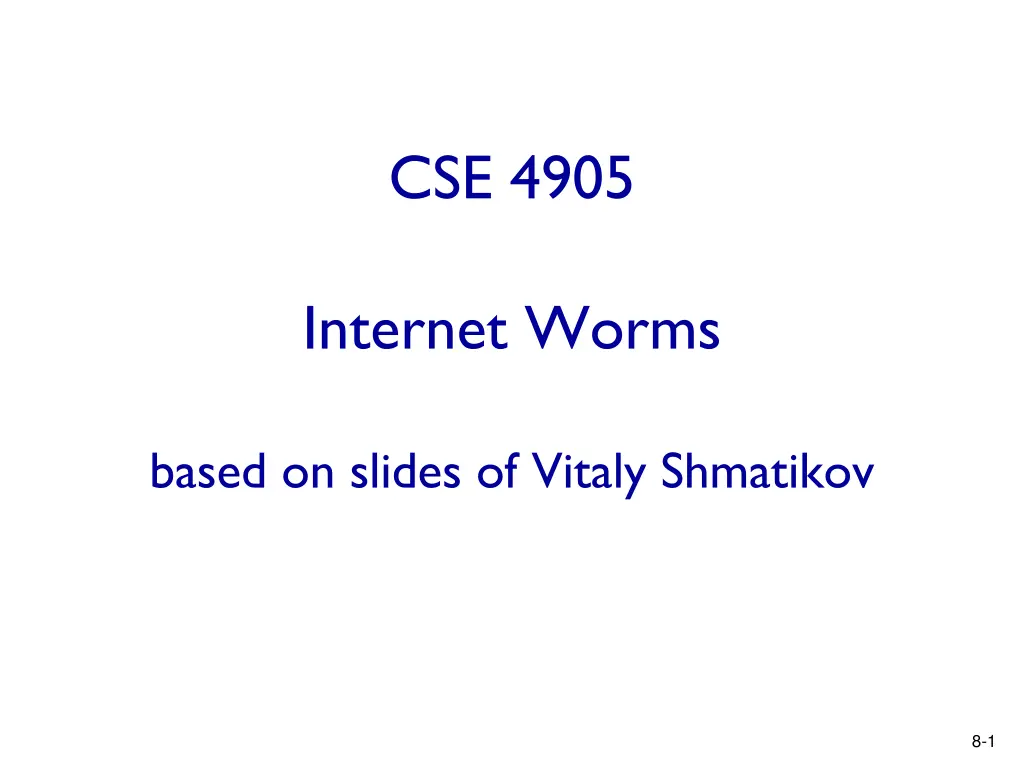
Understanding Internet Worms and Viruses: Threats and Propagation
Explore the distinctions between viruses and worms, their modes of propagation, the characteristics of a virus, and the strategies employed by worms to spread. Dive into the world of malware with insights on the Witty worm's pseudocode, worm propagation models, and infamous incidents like the Morris Worm of 1988.
Download Presentation

Please find below an Image/Link to download the presentation.
The content on the website is provided AS IS for your information and personal use only. It may not be sold, licensed, or shared on other websites without obtaining consent from the author. If you encounter any issues during the download, it is possible that the publisher has removed the file from their server.
You are allowed to download the files provided on this website for personal or commercial use, subject to the condition that they are used lawfully. All files are the property of their respective owners.
The content on the website is provided AS IS for your information and personal use only. It may not be sold, licensed, or shared on other websites without obtaining consent from the author.
E N D
Presentation Transcript
CSE 4905 Internet Worms based on slides of Vitaly Shmatikov 8-1
Viruses vs. Worms Virus Worms Propagates by infecting other programs Usually inserted into host code (not a standalone program) Propagates automatically by copying itself to target systems A standalone program 8-2
Virus Piece of software that infects programs Modifies them to include a copy of the virus Replicates and goes on to infect other programs Easily spread through network environments When attached to an executable program, a virus can do anything that the program is permitted to do Executes secretly when the host program is run Specific to operating system and hardware Takes advantage of their details and weaknesses Phases: dormant, propagation, triggering, and execution 8-3
A simple virus 8-4
Worms Program that actively seeks out more machines to infect; each infected machine serves as an automated launching pad for attacks on other machines Exploits software vulnerabilities in client or server programs Can use network connections to spread from system to system Spreads through shared media (USB drives, CD, DVD data disks) E-mail worms spread in macro or script code included in attachments and instant messenger file transfers 8-5
Pseudocode of Witty worm srand(get_tick_count()) for(i=0; i<20,000; i++) destIP rand()[0..15]|| rand()[0..15] destPort rand()[0..15] packetSize 768 + rand()[0..8] packetContents top of stack send packet to destIP/destPort if(open(physicaldisk,rand()[13..15])) write(rand()[0..14]|| 0x4E20); goto 1; 9. else goto 2 1. 2. 3. 4. 5. 6. 7. 8. 8-6
Worm propagation model Similar to epidemic model: Can be modeled using ODE (Ordinary Differential Equations) 8-7
Code Red infection rate 8 8-8
1988 Morris Worm No malicious payload, but bogged down infected machines by uncontrolled spawning Infected 10% of all Internet hosts at the time Multiple propagation vectors Remote execution using rsh and cracked passwords Tried to crack passwords using a small dictionary and publicly readable password file; targeted hosts from /etc/hosts.equiv Buffer overflow in fingerd on VAX Standard stack smashing exploit DEBUG command in Sendmail In early Sendmail, can execute a command on a remote machine by sending an SMTP (mail transfer) message 8-9
Understanding witty worm via network telescopes 8-10
Reference A. Kumar, V. Paxson, N. Weaver Outwitting the Witty Worm: Exploiting Underlying Structure for Detailed Reconstruction of an Internet-scale Event (IMC 2005) 8-11
Goals Understand the behavior of one specific worm (witty worm) Understand its propagation and its impact on Internet Network telescopes as tools for observing Internet-scale events 8-12
Witty Worm Exploits buffer overflow in the ICQ analyzer in ISS (Internet Security Systems) ICQ packet: UDP packet with source port 4000 Analyzer copies packet to fixed-size buffer standard stack smash Deletes randomly chosen sectors of hard drive Payload contains (^.^ insert witty message here ^.^) Chronology of Witty Mar 18, 2004: high-level description published 36 hours later: worm released 75 mins later: all12,000 vulnerable machines infected! 8-13
Pseudocode of Witty (1) srand(get_tick_count()) for(i=0; i<20,000; i++) destIP rand()[0..15] || rand()[0..15] destPort rand()[0..15] packetSize 768 + rand()[0..8] packetContents top of stack send packet to destIP/destPort if(open(physicaldisk,rand()[13..15])) write(rand()[0..14] || 0x4E20); goto 1; 9. else goto 2 Seed pseudo-random generator 1. 2. 3. Each Witty packet contains bits from 4 consecutive pseudo-random numbers 4. 5. 6. 7. 8. 8-14
Wittys PRNG Witty uses linear congruential generator to generate pseudo-random addresses Xi+1 = A * Xi + B mod M Witty: A = 214013, B = 2531011, M = 232, orbit is a complete permutation (every 32-bit integer is generated exactly once) Can reconstruct the entire state of generator from a single packet (equivalent to a sequence number) destIP (Xi)[0..15] | (Xi+1)[0..15] destPort (Xi+2)[0..15] try all possible lower 16 bits and check if they yield Xi+1 and Xi+2 consistent with the observations Given top 16 bits of Xi 8-15
CAIDA/UCSD Network Telescope Monitors /8 of IP address space Recorded all Witty packets it saw In the best case, saw approximately 4 out of every 1000 packets sent by each Witty infectee (why?) 8-16
Estimating Infectees Bandwidth Suppose two consecutively received packets from a particular infectee have states Xi and Xj Compute j-i Count the number of PRNG turns between Xi and Xj Compute the number of packets sent by infectee between two observations Equal to (j-i)/4 (why?) sendto() in Windows is blocking (means what?) Bandwidth of infectee = T: the interval between the two packets (j-i)/4 * packet size / T 8-17
Estimated infectees bandwidth 25% of infectees have access bandwidth of 10 Mbps 50% of infectees have access bandwidth of 100 Mbps 8-18
Estimating Infectees Bandwidth: Another approach Telescope observe 1/256 of the address space Telescope observes packets per seconds from an infectee, r Suppose average packet size is c bits Then infectee s bandwidth: 256*r*c How is this compared to the earlier approach? This is effective bandwidth (taking account of packet losses) Earlier approach calculates access bandwidth (some packets are lost) 8-19
Infectees access and effective bandwidth Effective bandwidth much lower than access bandwidth Due to packet losses; multiple infectees share a bottleneck 8-20
Inferring infection graph Compute every packet sent by every infectee Compute who infected whom Large address space of telescope infectee can be detected within a few seconds If an infectee A was first see at time T inspect list of packets sent by all other infectees active in a short interval (e.g., in past 10 seconds) If we find B sends a packet to A in the interval, then likely B infected A 8-21
Bug in Wittys PRNG Witty uses a permutation PRNG, but only uses 16 highest bits of each number Misinterprets Knuth s advice that the higher-order bits of linear congruential PRNGs are more random Result: orbit is not a compete permutation, misses approximately 10% of IP address space and visits 10% twice but telescope data indicates that some hosts in the missed space still got infected Due to an initial histlist , or maybe multi-homed or NAT ed hosts 8-24
Wittys Hitlist Some hosts in the unscanned space got infected very early in the outbreak Many of the infected hosts are in adjacent /24 s Witty s PRNG would have generated too few packets into that space to account for the speed of infection They were not infected by random scanning! Attacker had the hitlist of initial infectees Prevalent /16 = U.S. military base Likely explanation: attacker (ISS insider?) knew of ISS software installation at the base Worm released 36 hours after vulnerability disclosure 8-26
Patient Zero A peculiar infectee shows up in the telescope observation data early in the Witty oubreak Sending packets with destination IP addresses that could not have been generated by Witty s PRNG It was not infected by Witty, but running different code to generate target addresses! Each packet contains Witty infection, but payload size not randomized; also, this scan did not infect anyone Initial infectees came from the hitlist, not from this scan Probably the source of the Witty outbreak IP address belongs to a European retail ISP; information passed to law enforcement 8-27
Summary Witty worm mechanism Reconstruct entire PRNG state sequence using single packet from an infectee Estimate infectee access and effective bandwidth Estimate number of disks of an infectee Identify bugs in Witty PRNG Identify hitlist and patient zero General lessons? 8-28

